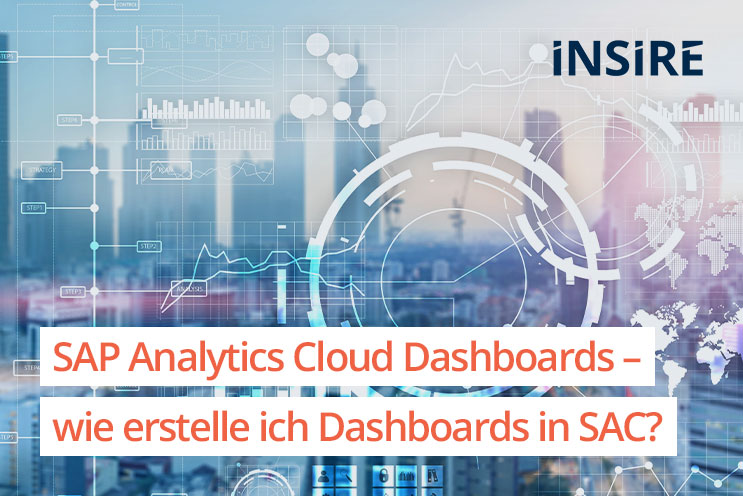The SAP Analytics Cloud Dashboard allows you to display the most important key figures in your company transparently and in a visually appealing way. Flexible, individual and tailored to your personal needs, an SAP Analytics Cloud dashboard offers numerous options for displaying live data for analysis, observation and evaluation.
Here we will tell you about the advantages of dashboards and how to create your first dashboard.
What are SAP Analytics Cloud Dashboards?
SAP Analytics Cloud Dashboards visualize the most important data of your company. You can share this as a story with colleagues, employees, customers or your management. The self-service idea of the cloud is the top priority: With the help of various setting and display options, you can optimally adapt planning, analysis and reporting to your business.
Why do I need SAP Analytics Cloud Dashboards?
The visualization in one SAP Analytics Cloud Dashboard gives you a consistent overview of your most important numbers and achievements. Studies have shown that colors promote the willingness to deal with numbers and data. The visualization also has the effect that we can recognize patterns more easily and detect exceptions and peculiarities in data sets more quickly. This allows for faster evaluation and better analysis of sophisticated data sets.
Which KPIs can I display with a SAP Analytics Cloud Dashboard?
The key performance indicators (KPIs) that you want to display in a SAP Analytics Cloud dashboard include all key figures that are important for your company's success. Earnings and liquidity are important criteria for controlling. In sales, turnover and goods sold are important.
A distinction can be made between absolute and relative key figures:
- Absolute key figures are mostly a sum or a difference. The absolute key figures include sales, cash flow and number of employees.
- Relative key figures represent the ratio of at least two absolute key figures. They are relationship key figures, index key figures or classification key figures.
If you would like to compare customer master data and sales data and add a geographical filter, this offers you SAP Analytics Cloud (SAC) has the appropriate functions for this.
How can I create a SAP Analytics Cloud Dashboard?
When creating a SAP Analytics Cloud Dashboard, you should first deal with a few important questions before you start implementation.
Among other things, it is important who you want to create your dashboard for:
- What information is of interest to users and viewers?
- How should the data be made available: is an online solution sufficient or should the results also be made available as a print version?
- Is a mobile display desired (responsive design)?
With regard to your story, it is important to answer the most important W-questions and to develop a common thread:
- How is your story structured (introduction – main part – conclusion)?
- What would you like to tell?
- What questions should the story answer?
- What data do you want to map in a SAP Analytics Cloud Dashboard?
- Which visualization is best?
These preliminary considerations result in specific requirements for your data source. Before you import your data, you should check whether these requirements are met or whether important information is missing.
1. Import data and create model
To create a SAP Analytics Cloud Dashboard, the first step is to import your data into the SAC. To do this, click the data model icon in the sidebar. A special feature of the SAC is the possibility of consolidating data sources. You can upload your data as an Excel file or link the cloud to another source system. For example, a dashboard can be created from data from SAP BPC, SAP BW4/HANA or from an external system. Thanks to this function, you can display live data in your report, among other things.
The system recognizes the predefined dimensions and measures. You can adjust these if necessary. You can also combine different data sets with one another using drag-and-drop. Smart Transformations help you adjust minor inconsistencies in your datasets.
2. Create story
Once your data has been imported and the connection to your source system has been established, you need to create a story for your SAP Analytics Cloud Dashboard. In addition to templates and a guided guide, there are customer-specific or user-defined solutions that you can use on the platform. A simple bar chart is enough to get you started.
When creating your SAP Analytics Cloud Dashboard, it is recommended to comply with the ibcs standards. These are practical suggestions to help you unify the design of key metrics, titles, and information in business communications.
In addition to your central key figure (e.g. profit, turnover, costs or goods sold), you can display geographical data, time periods, development as well as planned and actual figures in your SAP Analytics Cloud Dashboard.
How to proceed:
- Click on the main menu Create - Storyto create a responsive page.
- About Insertion connect to your model.
- The Designer on the right will help you create your site. Define your measures and dimensions and determine coloring, levels and filters. Previously defined time periods or geographic data can be used as filters.
- Under Styling you can customize the font, size, and color of your chart, as well as set the number format and number of decimal places in your data.
- Finally, choose a suitable sorting for your KPIs.
3. Your home page
Your first successfully created SAP Analytics Cloud Dashboard can be found on your homepage. Your KPIs are displayed as charts in tile form. You can see at a glance
- Title
- Value
- Current selected period
- Microchart with bars
- context to the previous period
Filters are available in the left pane. You can use these to customize the display. Instead of or in addition to a bar chart, you can pull additional information from your data. Among other things, you can display world maps or insert combined bar charts. Other forms of representation are:
- 3D column charts
- Multi Line Charts
- Multiple Pie Charts
- scatter plots
- Box Plot Diagrams
- bubble charts
- radar charts
- waterfall charts
SAP Analytics Cloud Dashboard with INSIRE
Would you like to know whether a SAP Analytics Cloud Dashboard can map your planning and reporting requirements?
As an experienced SAP partner, we support you with data import and the design of your most important KPIs in the SAC. We would be happy to link your data sources for you, manage reports for you and identify areas for optimization. Contact us and let us advise you without obligation.


